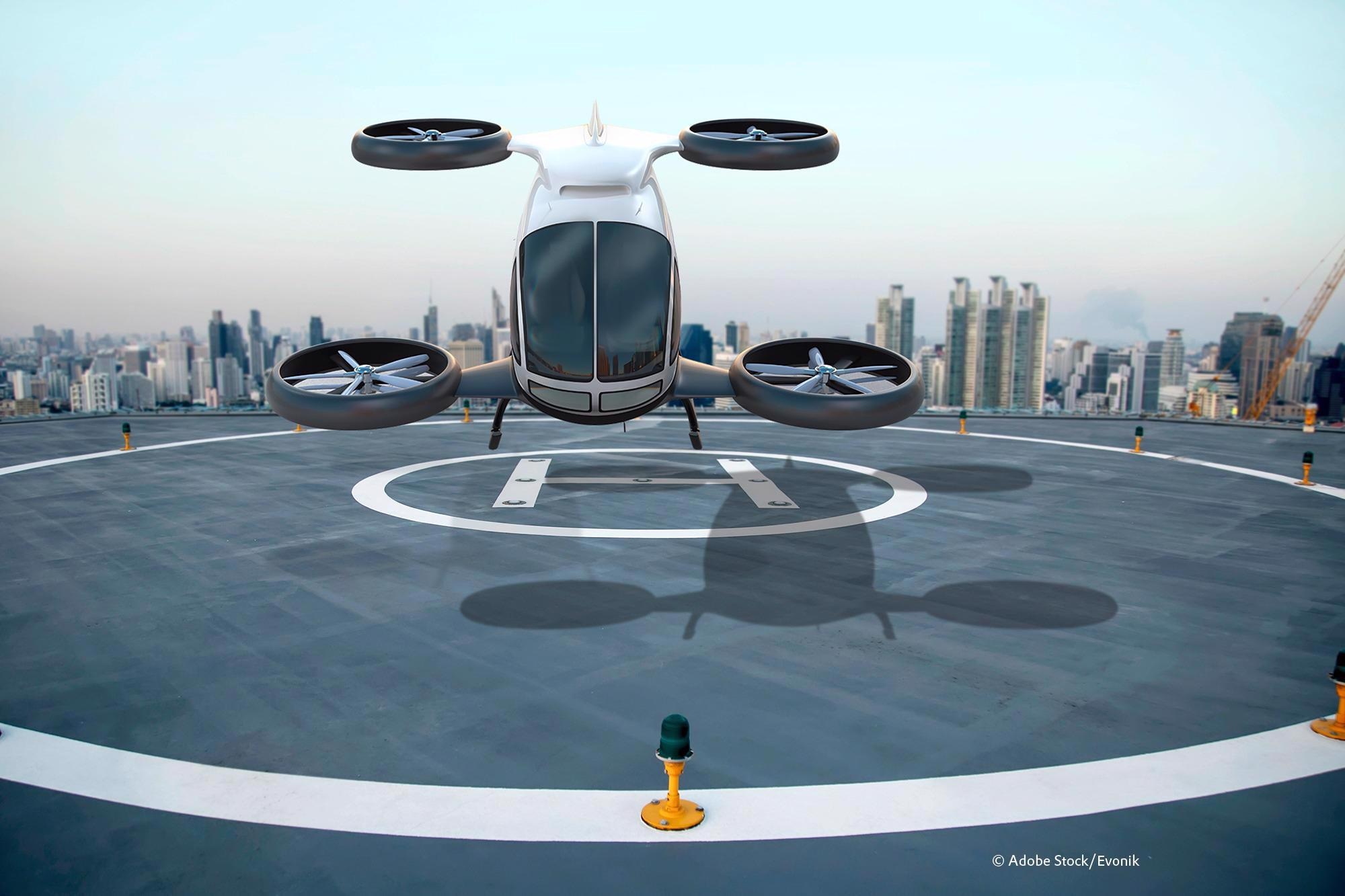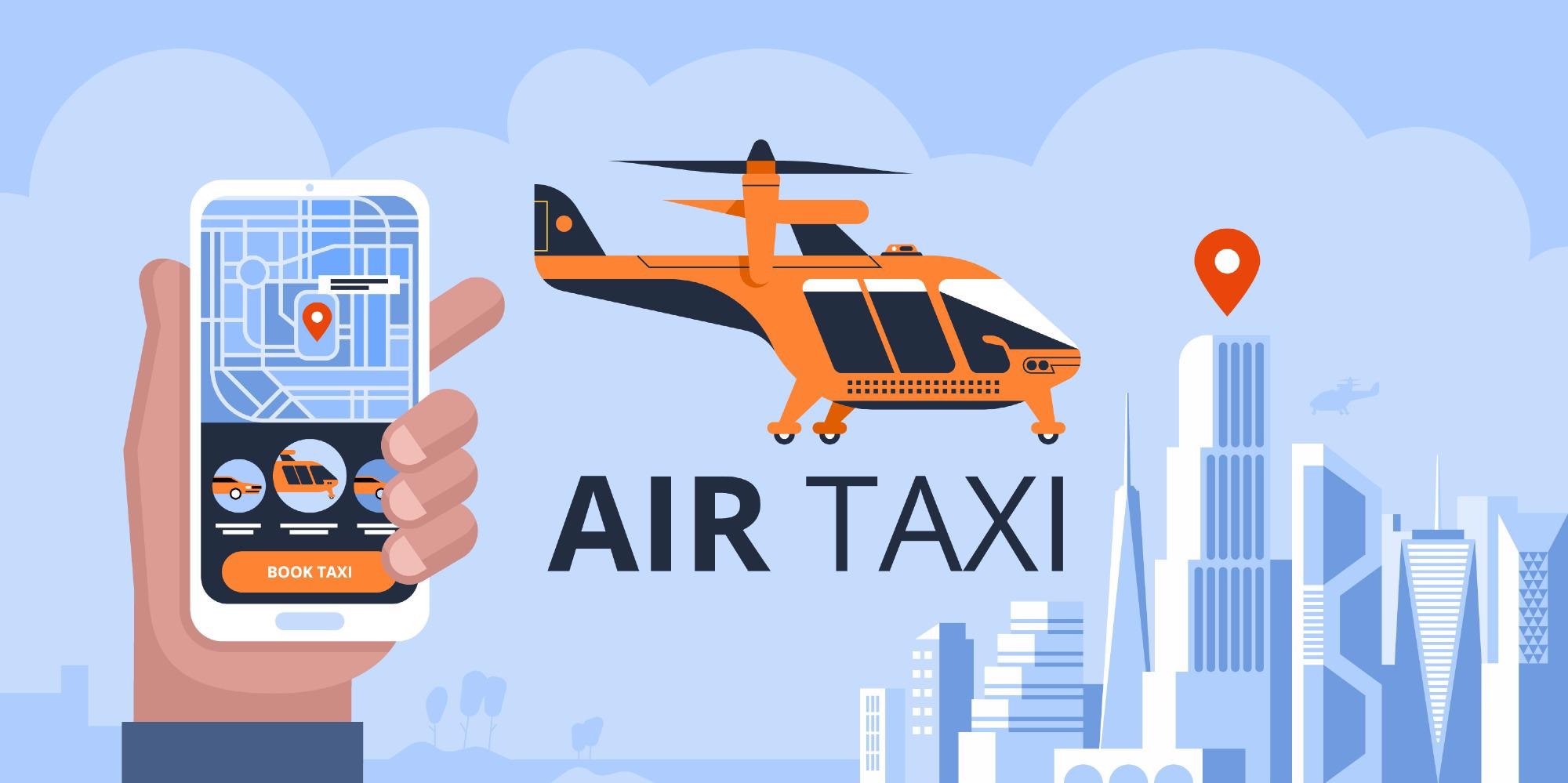 Interview conducted by Olivia FrostDec 8 2021
Interview conducted by Olivia FrostDec 8 2021To begin, can you give us an introduction into air taxis and ‘Electric Powered Vertical Takeoff and Landing Aircraft’ (eVTOLs)?
Some say flying cars, others say air taxis, but I simply describe them as sustainable and quiet helicopters. I believe this basic description provides a better understanding of the new breed of air vehicles and clarifies what sets them apart from traditional helicopters.
We are clearly living a disruptive moment in technology, encouraging the development of a new mode of transportation. It’s a revolution in Urban Transportation, and it’s bringing vehicles to the skies that offer some of the most innovative features and designs we’ve ever seen.

Image Credit: © Adobe Stock/Evonik
Electric Vertical Takeoff and Landing (eVTOL), as unfriendly as it sounds, is the newest buzz word and it accurately describes these vehicles of the not-so-far-away future. “Electrical” expresses the goal of zero CO2 emissions, and “vertical take-off and landing” clarifies their ability to operate inside urban areas, cleanly and quietly, while moving people above the crush of dense and chaotic traffic in our cities.
More than 150 market players are currently working on vehicle development – split between established aircraft OEMs (Original Equipment Manufacturers) and multiple startups and major suppliers in the automotive sector.
What is the driving force behind the emerging market of urban air mobility?
Different forces are at play in the emergence of this new transportation segment. Environmental drivers like traffic congestion and the resulting high CO2 emissions are a huge issue for megacities around the world. Many of these dense metropolitan areas lack adequate public mass transportation options, like subways and trains – making them prime candidates for creative transportation options.

Image Credit: Shutterstock/Ali _Cobanoglu
Another equally important driver is the high level of technology development happening – increasing dependence on internet connectivity, battery solution development for electric vehicles, and the importance of lightweight construction technology, just to name a few.
Add to that, the possibility of different business models created by shared economy and shared mobility concepts. Urban air mobility is introducing a type of transportation that was previously only available to the very wealthy with access to a private helicopter. In the future, urban air transport will also be available to a greater part of the society for not only daily transportation but also the capability to address critical societal needs like emergency response and remote area access.
The ultimate goal is to make this transportation option accessible to basically everyone in a city with access to a smartphone and an app to request transportation services.
How far into the future is the reality of air taxis and which countries are driving it forward?
This is an interesting question because right now, one or two big players are active in each major region, and they are projecting different timelines. Some players are operating on a more conservative timeline, while others aim to be “up and running” in the next two years.
We have observed developers from Europe conducting test flights this year. Planning operations are happening in Asia as we speak. Countries like South Korea and Singapore have already received substantial support from their authorities. In a highly regulated field like aerospace, governmental support can be a major influencing factor on the speed of development and the success of going to market with new technology.
In the United States, Joby Aviation is an advanced startup leading the critical FAA approval process. In Europe, German startup Volocopter plans to fly in the Paris Summer Olympics in 2024, while Lilium leads on the regional transportation business model. In South America, a potential market for Urban Air Mobility, Embraer subsidiary Eve has announced launch plans for 2026.
At this moment, no one country is the global driving force, but most industry experts agree that the United States has some of the most advanced and motivated startups to date. Meanwhile, in Europe, Germany is counting on startups with disruptive technology. Perhaps the region with the most promising market potential due to its sheer size is Asia, where offers are coming from local developers who have a lot to show to the industry. Eve in South America relies on Embraer’s extensive aviation experience and valuable partnerships for the region. Right now, the scenario is fluid, open, and emerging at different speeds in each region.
What is the current status of urban air mobility, and what are the different types of air taxis?
Simply put, fast development and new discoveries. The year 2020 was, in contrast to the rest of the aviation market, a year of growth for the UAM market. Several startups were granted valuable capital investment to secure their prototypes and further their company's development. The year 2021 saw many companies going public on stock markets, giving the outside world more visibility to their development stage and providing a clearer overview of the status of the market and the technology.

Image Credit: Shutterstock/Ico Maker
Regarding the technology, we observed extensive adaptation of eVTOL prototypes. Companies that had previously focused on a small-range vehicle with a short-range capacity have begun shifting development to design larger vehicles that accommodate up to 5 passengers and are able to travel longer distances for regional mobility. We observed this happening at Airbus UAM, Volocopter, and EHang. These companies' first vehicle prototypes focused on a basic passenger drone design, but now the designs have evolved to resemble a small jet that uses propellers for vertical take-off and landing.
What are the different application possibilities for air taxis?
Different business models are emerging in the air taxi industry. The first and most apparent, and where the term “taxi” applies most easily, has a goal of providing air transportation inside a large city, from landing port to landing port (called Vertiports). Think of transport “on-demand” ordered via an app on your phone and operating over a small distance using a short-range vehicle.

Image Credit: Shutterstock/Ico Maker
Offering equal potential is a service similar to an airport shuttle. Many airports are not well connected to the regions they serve. Even before boarding their airplane, travelers often face long or congested commutes in a car to simply get to and from an airport. In this business model, travelers skip the road traffic (and airport parking) and instead connect directly to their flight via an eVTOL shuttle to the airport where they can seamlessly board an airplane.
Other eVTOL vehicles are being developed that fly longer distances and carry more passengers. This would provide transportation between cities, ranging from 50 to 300 km (30 to 185 miles), connecting important economic hubs and opening up new possibilities for business and personal travel.
Perhaps one of the most interesting and pressing applications is the use of eVTOLs as emergency response vehicles. The ability to quickly arrive at a scene by air with life-saving equipment and personnel, plus eliminate delays due to traffic congestion on the ground, has a massive value that can’t be put into a spreadsheet calculation.
Can you give us an introduction into your product ‘ROHACELL®” – what is it, and what sets it apart?
ROHACELL® is a family of PMI-based, rigid, structural foams from Evonik Performance Foams introduced in the 1970s. Evonik is a market leader in providing high-performance foam materials that have been used in lightweight sandwich construction designs for the last 50 years. ROHACELL® is one of the most innovative and reliable foam core products qualified for use in the aerospace market today. It is known for its unique combination of benefits that include a closed-cell structure, high specific strengths, isotropic nature, as well as compatibility with all composite processes and all common thermoplastic and thermoset matrix systems.
The closed-cell structure of the foam provides both cost and weight-saving benefits. That’s because during the processing of ROHACELL® cored parts, resin fills the cut surface cells but goes no further into the foam, thus providing a secure bond to face sheets while using the optimal amount of resin. Less resin means lower weight and lower cost. ROHACELL® can be shaped into both simple and complex geometries using common machining methods, including milling, drilling, turning, sanding and thermoforming.
What are the strengths of ROHACELL®?
All ROHACELL® foams provide impressive mechanical strength and stiffness, even at very low densities, and a heat distortion temperature and creep compression strength superior to any other rigid foam. For select grades, the properties can be further enhanced by heat treatment.
When you use ROHACELL® foam cores in sandwich construction, the result is a robust and durable composite. The high glass transition temperature (Tg) of ROHACELL® and its exceptional creep compression strength provide good consolidation of face sheets during processing, even during very short and intense production cycles.
The high-performance foam can be processed at temperatures as high as 190 °C (374 °F) and pressures up to 0.7 MPa (102 psi) over several hours. Even temperatures up to 210 °C (428 °F) are possible in a pressure-free post-cure process.
Our foam products meet the needs of literally any high-performance application industry that is using composites. Customers can choose from a wide variety of product grades that feature cell sizes tailored to a customer’s specific processing method. Selected products are engineered specifically for the aerospace industry.
How is ROHACELL® different from other structural core materials on the market?
ROHACELL® solves many of the well-known issues customers face when using alternative core materials, like honeycomb that provides no closed-cell benefits or other foams that cannot successfully withstand higher temperatures and pressures during processing.
ROHACELL® foams offer integral design capability with an unmatched degree of design freedom, plus its processing advantages, such as one-shot curing, opens up the ability to use innovative production methods like RTM and liquid resin infusion for sandwich design composites.
Always looking to the future, ROHACELL® is the ideal material solution for time- and cost-efficient automated composite production by being an inherently stiff foam core that is easy to transfer with the use of robotic placement arms. It’s truly the foam with a long and proven history of success and the foam that is engineered to meet the needs of the future.
About Analli Carvalho
Analli Carvalho is a Business Development Manager with Evonik Performance Foams - ROHACELL®, responsible for the Urban Air Mobility, Air Taxi, and Delivery Drone markets in the Aerospace Segment.
Analli studied international relations at the University Rio Branco in Brazil and acquired a Master’s degree in Marketing at the Universitat Autonoma de Barcelona in Spain. Joining Evonik in 2017, she has held Marketing and Sales positions in Brazil, Germany and the United States.
Disclaimer: The views expressed here are those of the interviewee and do not necessarily represent the views of AZoM.com Limited (T/A) AZoNetwork, the owner and operator of this website. This disclaimer forms part of the Terms and Conditions of use of this website.